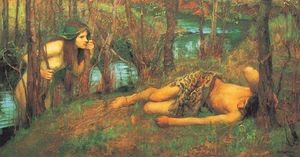Naiad

In Greek mythology, the Naiads or Naiades (Ναϊάδες from the Greek νάειν, "to flow," and νἃμα, "running water") were a type of nymph who presided over fountains, wells, springs, streams, and brooks.
They are distinct from river gods, who embodied rivers, and the very ancient spirits that inhabited the still waters of marshes, ponds and lagoon-lakes, such as pre-Mycenaean Lerna in the Argolid.
Naiads were associated with fresh water, as the Oceanids were with saltwater and the Nereids specifically with the Mediterranean, but because the Greeks thought of the world's waters as all one system, which percolated in from the sea in deep cavernous spaces within the earth, there was some overlap. Arethusa, the nymph of a spring, could make her way through subterranean flows from the Peloponnesus, to surface on the island of Sicily.
Contents |
Mythology
| Greek deities series |
|
|---|---|
| Primordial deities | |
| Titans and Olympians | |
| Chthonic deities | |
| Personified concepts | |
| Other deities | |
| Aquatic deities | |
|
|
| Nymphs | |
|
|
The essence of a naiad was bound to her spring, so if a naiad's body of water dried, she died.
They were often the object of archaic local cults, worshipped as essential to humans. Boys and girls at coming-of-age ceremonies dedicated their childish locks to the local naiad of the spring. In places like Lerna their waters' ritual cleansings were credited with magical medical properties. Animals were ritually drowned there. Oracles might be situated by ancient springs.
Naiads could be dangerous: Hylas of the Argo's crew was lost when he was taken by naiads fascinated by his beauty (see illustration). The naiads were also known to exhibit jealous tendencies. Theocritus's story of naiad jealousy was that of a shepherd, Daphnis, who was the lover of Nomia; Daphnis had on several occasions been unfaithful to Nomia and as revenge she permanently blinded him. Salmacis forced the youth Hermaphroditus into a carnal embrace and, when he sought to get away, fused with him.
The Naiads were either daughters of Posidon or various Oceanids, but a genealogy for such ancient, ageless creatures is easily overstated. The water nymph associated with particular springs was known all through Europe in places with no direct connection with Greece, surviving in the Celtic wells of northwest Europe that have been rededicated to Saints, and in the medieval Melusine.
Walter Burkert points out, "When in the Iliad [xx.4–9] Zeus calls the gods into assembly on Mount Olympus, it is not only the well-known Olympians who come along, but also all the nymphs and all the rivers; Okeanos alone remains at his station,"[1], Greek hearers recognized this impossibility as the poet's hyperbole, which proclaimed the universal power of Zeus over the ancient natural world: "the worship of these deities," Burkert confirms, "is limited only by the fact that they are inseparably identified with a specific locality."[1]
Interpretation

Robert Graves offered a sociopolitical reading of the common myth-type in which a mythic king is credited with marrying a naiad and founding a city: it was the newly arrived Hellenes justifying their presence. The loves and rapes of Zeus, according to Graves' readings, record the supplanting of ancient local cults by Olympian ones (Graves 1955, passim).
So, in the back-story of the myth of Aristaeus, Hypseus, a king of the Lapiths, married Chlidanope, a naiad, who bore him Cyrene. Aristaeus had more than ordinary mortal experience with the naiads: when his bees died in Thessaly, he went to consult them. His aunt Arethusa invited him below the water's surface, where he was washed with water from a perpetual spring and given advice.
Types of Naiads
- Crinaeae (fountains)
- Limnades or Limnatides (lakes)
- Pegaeae (springs)
- Potameides (rivers)
- Eleionomae (marshes)
Individual Naiads
- Abarbarea
- Aegle
- Annaed
- Arethusa
- Bateia
- Bistonis
- Byzia, naiad said to have raised Byzas, founder of Byzantium
- Callirrhoe
- Castalia
- Charybdis
- Cleochareia
- Corycian nymphs
- Corycia
- Kleodora or Cleodora
- Melaina
- Creusa
- Drosera
- Echenais
- Harpina
- Lara
- Lethe
- Lilaea
- Melite
- Minthe
- Nomia
- Orseis
- Periboea
- Pitane
- Praxithea
- Salmacis
- Styx
See also
Notes
References
- Bibliotheca (Pseudo-Apollodorus) 2.95, 2.11, 2.21, 2.23, 1.61, 1.81, 1.7.6
- Homer. Odyssey 13.355, 17.240, Iliad 14.440, 20.380
- Ovid. Metamorphoses
- Hesiod. Theogony
- Walter Burkert, Greek Religion 1985, Harvard University Press, III 3.3
- Robert Graves, The Greek Myths 1955
External links
|
||||||||||||||||||||||||||||||||